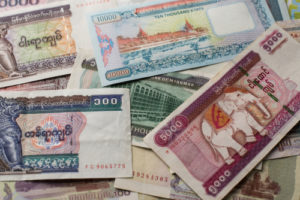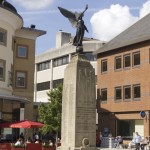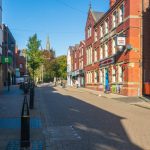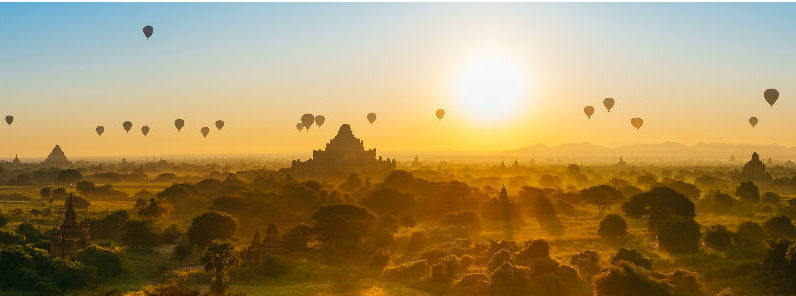
A quick guide to Myanmar
After more than 30 years of limited access and restricted travel for foreigners, Myanmar’s military regime finally opened the doors to mainstream international tourism in 2011. I first arrived in the country a couple of years later, and with my western media fuelled preconceptions, I half expected the streets to be overrun with ox-carts, rickshaws and bicycles. This, of course, was nothing like reality, the roads were packed, but mostly with new or near new cars.
However, mainly due to that three decades of self-imposed isolation, resulting lack of development and freedom from western influences, Myanmar for now at least, has a feel of being one of Asia’s most ‘authentic’ nation-states. Inevitably, life is changing, as access to modern conveniences like mobile phones, the internet, ATM’s, etc. are gradually being rolled out across the country. Adding to the momentum of change, tourist numbers are rising steadily, year on year.
However, many potential travellers to Myanmar are probably unaware that large swathes of the country have travel restrictions imposed or are totally out of bounds to foreign tourists.
Getting around – planes, trains, automobiles and boats
Travel restrictions
To best understand Myanmar’s travel restrictions, it perhaps requires a little knowledge of the country’s demographics and the geopolitical situation. Eight main ethnic groups have Government recognition in Myanmar, but these are further broken down into some 135 sub-groups, who speak around a hundred different languages or dialects.
The indigenous Bamar (aka Burman) are the main ethnic group and makeup almost 70% of the population. The Bamar predominately live in the seven designated administration regions of the country. The other seven most populous ethnic groups each have their own state i.e. Mon, Kayin (Karen), Rhakine, Chin, Kayah, Shan and Kachin.
These States have varying degrees of autonomy from central government, most having their own army. There is an ongoing conflict between the regular army and the local militia/insurgents in all States. Land mines are a risk in some parts of Shan, Kachin, Chin and Rakhine States and there have been past reports of tourist injuries in these areas. Thus, strict travel restrictions are imposed by the government on those areas deemed too risky for travellers.
A journey taken to some restricted areas can be tough. Places to stay and eat might be thin on the ground. Expect accommodation to be somewhat less than rudimentary. Typically, prepare for a tiny room, rough and ready wash facilities and a makeshift bed. Long power cuts through the night can be anticipated as a matter of course. There could well be no mobile phone network coverage. Any available public transport will be scarce and probably impracticable for getting around. If you provide your own, expect to pay around $100 per day for a suitable (4 x 4) vehicle, which will include the cost of providing a driver, their expenses and fuel.
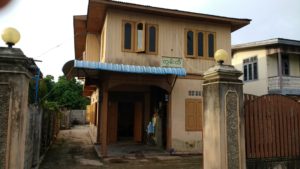
Not quite the Hilton! – A typical guesthouse in a travel restricted area of the southern Shan State
Airports and planes
Myanmar currently has three international ports in Yangon (Rangoon), Mandalay and Nay Pyi Taw. There are also 21 domestic airports spread throughout the country, operating commercial flights. A new international airport at Bago, around 48 miles from Yangon, is also currently under construction.
Most international flights arrive at Yangon International Airport, flying direct from either Bangladesh, China, Hong Kong, India, Korea, Malaysia, Qatar, Singapore, Thailand, UAE and Vietnam. You can also fly directly into Mandalay International Airport from China, Hong Kong, India, Singapore and Thailand, and Nay Pyi Taw International Airport from China and Thailand.
Flying offers an ideal mode of transport in Myanmar, given some of the vast distances and journey times involved by alternative travel means. Domestic air ticket prices are generally affordable, usually being cheaper to book through an agent than directly with the airline. You can sometimes find offers where you can buy 3 or 4 tickets between the mainstay tourist destinations at a decent knock-down price.
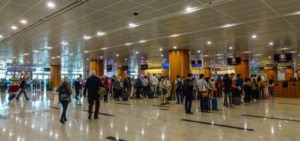
Yangon’s recently extended and refurbished international Mingaladon Airport
Trains
Myanmar Railways (MR) is the state-owned agency that operates the railway network in Myanmar. The 5,403 km metre gauge rail network generally spans north to south, with branch lines to the east and west, and with Yangon as its central hub.
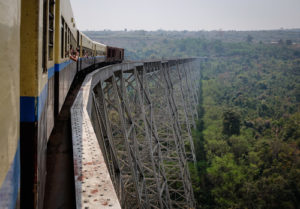
The famed Goteik Viaduct, Nawnghkio, Shan State
With the exception of the Yangon – Mandalay line, much of the railway infrastructure is in a state of poor repair. Rolling stock can best be described shabby to decrepit. Long delays on rail journeys are routinely expected. On the showpiece, 700 km Yangon – Mandalay route, train speeds can average a giddy 50 kph. However, as a consequence of very poor infrastructure, average speeds on other routes can be as low 15 km, and on occasions even lower.
The train can be a great way to see the country but is obviously only for those with time on their hands. There are 3 travel classes; Upper, First and Ordinary, distinguished only by the comfortability of the seating. However, sleeper classes are gradually being introduced on the most popular routes. Expect a noisy, bumpy ride whatever class you’re travelling in. It can also be quite chilly overnight, especially during the cold season, so passengers need to take appropriate clothing.
Some of the most popular rail journeys taken by foreign travellers are:
- Yangon to Mandalay
- Yangon to Bagan
- Yangon to Mawlamyine
- Mandalay to Myitkyina
MR also operates the Yangon Circular Railway, which is primarily used by local commuters. The line starts at Central Station and loops around the outskirts Yangon for some 28 miles. The original line was built by the British during colonial times but it was upgraded to double-track in 1954. The authorities first mooted ambitions to upgrade the track and rolling stock of the line in 2012. Work finally got underway in 2017 when the Yangon City Development Committee secured a loan from the Japanese Development Agency.
Trains leave the main station about every hour, starting around 8.30 am. The whole journey takes about 3 hours and costs around $0.20. Tickets can be bought at any of the 38 stations found on the circuit, or at Yangon’s Central Railway Station.
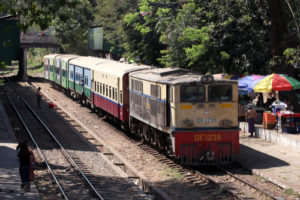
Yangon’s antiquated Circular Line railway is currently being updated
Buses
Numerous private operators alongside government provide bus services throughout the country. The bus will be generally faster and a bit more reliable than the train. However, the road network is mostly narrow, in a poor state of repair and can be very congested in built-up areas. Thus, average bus speeds don’t rank greatly above those of the train. If you’re travelling the main inter-city route you’ll be able to travel in relative luxury on a deluxe a/c bus. On other routes, you might end up on an over-crowded, dilapidated, rattletrap. During all long-distance journeys, buses make toilet/rest stops every 2 to 3 hours.
Very long-distance bus journeys (12 hours +) nearly always start between 4 pm and 10 pm, so they arrive at their destination very early morning, around 5 or 6 am. Shorter-haul journeys tend to start very early morning, again around 5 or 6 am. This way, passengers are spared travelling during the hottest part of the day, and buses avoid (less) overheating.
As a foreigner, expect to pay a little more than locals for your bus ticket. It often makes sense to book through your hotel, given the small commission involved, as bus stations in large cities are often located a little way out of town. During the visitor’s high season, November to February, it would be wise to book up 2 or 3 days in advance on any main tourist routes e.g. Mandalay to Bagan, Bagan to Inle Lake, etc.
Boats
Boats have traditionally always been an important method of transport in Myanmar, however, in the passage of time, their importance is diminishing. Nonetheless, the government-owned Inland Water transport operates a fleet of around 350 boats, which still sail much of the country’s 5000 km of navigable river.
The most popular ferry route taken by tourists is the 30 hour trip between Mandalay and Bagan (and vice versa). It’s possible to complete the same journey in more comfort, and in under 12 hours, if you chose a private operator. Prices vary markedly depending on the size and comfort level of the boat but expect to pay around 30 – 50 USD for the trip.
It’s also possible to take a journey on board a luxury river cruiser on either a restored antique steamer or new-built replica. Typically, cruises last from 5 to 14 days.
Money, money, money
Currency
The only official legal currency in Myanmar is the Kyat (MMK or K), pronounced ‘chat’. However, prices are often quoted in USD as well as Kyat, for larger purchases. You might be expected to pay in dollars for hotels, at high-end restaurants, flights, etc. If payment is made in Kyat, the exchange rate given may well be below market rate.
The exchange rate (Nov 2018) between the Kyat and the USD is currently around 1600 Kyat to 1 USD. Banknotes are issued in denominations of 50, 100, 200, 500, 1,000, 2,000, 5,000 and 10,000. The value of the Kyat against the USD has steadily fallen over the past 4 or 5 years from around 1000 to its current rate. However, since most businesses patronised by foreign tourists price in USD, this hasn’t resulted in any real fall in costs for the traveller.
Currency Exchange
Myanmar is very much, perhaps not unsurprising, a cash-based economy, where the ready dough is king. You can bring up to $10,000 (or equivalent) in cash into the country without any declaration to Customs. However, the only currencies you will find you can ordinarily exchange are the USD, the Euro, and the Singapore Dollar. Banknotes need to be new or in near mint condition, otherwise, they will be difficult to exchange. Similarly, USD banknotes predating 2006, will not be readily accepted.
The exchange rates at airports are usually more or less the same as the rate you can get in town. Money can be readily changed at banks in the downtown areas of larger cities. In Yangon, you can also head to the centrally located Bogyoke Aung San Market (Scott’s Market) if you want to change money. Here, you can find numerous money-changing shops that also open on Saturdays and some Sundays. Note that touts on the street around popular tourist areas in Yangon, especially the Sule Pagoda, will offer you good exchange rates. They should be avoided, as most, if not all, are scam artists!
ATM’s, Bank Cards and Traveller’s Cheques
An increasing number of hotels, restaurants and retailers now accept credit and debit cards, but there’s still widespread distrust of electronic payment and banking. If you intend to pay for hotels or restaurants with a credit or debit card, you should confirm that this will be possible. Many vendors will charge a high service fee for paying by card.
There are now many ATM’s that accept international bank and credit, located around the country, though most are concentrated in the main tourist areas i.e. Yangon, Mandalay, Nay Pyi Taw, Bagan and Inle Lake. Currently, only Visa, Mastercard (Maestro/Cirrus), China’s Union Pay and Japan’s JCB can be used at selected local banks, as there are no international banks in Myanmar.
ATM cash withdrawals typically incur an equivalent 3 USD transaction fee, with a withdrawal limit of around 200 USD. Be aware that the use of ATM’s is often affected throughout the country by the availability of the internet.
Traveller’s cheques are not generally accepted in Myanmar.
Climate – when to go?
Like most of South East Asia, Myanmar has a tropical climate consisting of three seasons. Generally, the hot season runs March to May, the rainy season June to November and the cool season December to February. However, Myanmar is a huge country of diverse topography, ranging from the Hkakabo Razi peak (19,289 ft) on the Tibetan border in the extreme north to the Ayeyarwady Delta region in the south. Thus, meteorological conditions can be quite varied throughout the country at any one time.
The coolest months in Myanmar are December and January, while the hottest months are April and May. However, from March onwards, humidity levels begin to rise steadily throughout the country, peaking June to September. It’s possible for the rains to erupt as early as mid-May and last through until October. In some parts of the country, especially the Delta region, it can often rain for days on end and cloudbursts can last for several hours at a time. Consequently, travel during this period can become problematic due to severe flooding. Additionally, cyclones habitually cause devastation along the coastal plains and the Ayeyarwady Delta area. Flight schedules to coastal regions at this time are usually severely reduced.
In the capital, Yangon, the average daily temperate varies between 30 °C and 36 °C throughout the year. However, the daytime peak temperatures can typically reach 40 °C (104 °F) between March and May. Areas around Mandalay and Bagan can be even hotter. For those planning to travel further north to higher altitudes, it is advisable to take warmer clothes, particularly in the cool season, when temperatures can drop significantly.
In essence, as with other South-East Asian countries, the best time to go to Myanmar is the cool season. If you go March to May there will be fewer tourists but be prepared for prolonged spells of hot weather. To go during the rainy season can be a bit of a gamble, but much depends on where you want to go and what you want to do?
Accommodation – where to stay?
Myanmar is generally more expensive for accommodation than its South-East Asian neighbours. Notably, the standard of accommodation can also vary quite dramatically for similarly priced rooms. However, as with all other travel destinations, it goes without saying that the internet is the first place to look for a good deal on accommodation.
In 2013, accommodation prices were at a premium in Myanmar, since supply was outstripped by the sudden dramatic rise in tourist numbers, albeit from a low base. However, since then, the availability of new guesthouse and hotel accommodation has been rising steadily throughout the country, especially at the main tourist destinations.
Basic accommodation in Myanmar usually consists of an en-suite room in a guesthouse. Expect to pay around 25 USD per night, although you might also be able to find rooms with a shared bathroom at a slightly cheaper rate. A double room in a mid-range hotel would be anywhere between 50 – 100 USD. If you haven’t booked ahead, it’s well worth having a scout around. Notably, in Yangon, I have previously managed to find a superior room, for half the price, in much the same location, of earlier viewed accommodation.
Similar to lots of places, new boutique style accommodation is opening in Myanmar’s main tourist areas, in competition to the up-market hotel scene. The very best hotels and resorts offer fantastic luxury, but at a price. Normally, they are built in a colonial or regal style, with large exotic gardens and offer top international grade leisure facilities with gourmet restaurants.
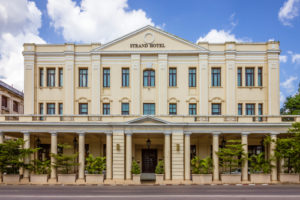
The iconic five-star Strand Hotel in Yangon
- Basic guesthouse: $15 – $25
- Mid-range hotel: $50 – $100
- New boutique style hotel: $125 – $175
- Up-market hotel: $125 – $200
- Luxury hotel: $400 – $500+
It should be more than possible to negotiate a discount on many of the advertised prices during the tourist low season i.e. March to October.
Visas
Almost everyone requires a visa for Myanmar, except passport holders from a list of 12 Asian countries, who can enter for tourism and business visits for up to 14 days.
It possible for most travellers to apply for a Myanmar e-Visas online for tourism and business purposes. An e-Visa is issued within 3 working days, is valid for 90 days from the date of issue and allows a stay for up to 28 days (for tourists) or 70 days (for business travellers). The fee for a business e-Visa is US$70, while a tourist e-Visa costs US$50. There is a fee of US$9 added to the price for government services.
Holders of e-Visas must enter from one of the following ports of entry:
- Yangon International Airport
- Nay Pyi Taw International Airport
- Mandalay International Airport
- Kawthaung Land Border Checkpoint with Thailand
- Myawaddy Land Border Checkpoint with Thailand
- Tachileik Land Border Checkpoint with Thailand
- Rih Khaw Dar Land Border Checkpoint with India
- Tamu Land Border Checkpoint with India
If you are an ASEAN country its still possible to obtain a business visa on arrival, whereby you will need a Letter of Invitation from the sponsoring company, and a copy of their official Myanmar registration document.
The other option is to apply for a visa either through the Burmese embassy in your own country or that of a country on your travels. I guess for many travellers that place will be the Burmese Embassy in Bangkok, which is located in Sathon Road, Silom.
The standard price for a 28 days tourist visa for Myanmar in Bangkok is 1600 THB (50 USD). The processing time for a visa is up to 3 working days. If you’d prefer, you can collect the visa the next day, paying an extra 500 THB fee. Express same-day visa service is also available for an extra 650 THB. Visa application is only possible between 9 am and 12 noon on weekdays. Queues are likely to be long, so make sure you go early. Visa collection is between 3.30 pm – 5 pm on weekdays
In applying for a visa, your passport will need at least six months validity and have at least one blank page. You will also require two passport-sized photographs.
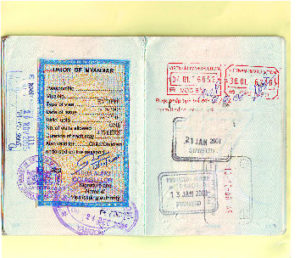
Where to go/what to do – at a glance
Just some of the things you could do at Myanmar’s four main tourist destinations are:
Yangon
- Visit the epic Schwedagon Pagoda complex
- Ride the city’s circular railway (3 hours)
- Visit the Taukkyan War Cemetery
- Take a stroll around Maha Bandula Park
- Shop at the famed Bogyoke Aung San (Scott’s) Market
- Visit the Bogyoke Aung San Museum – last home of General Aung San
- Take a guided sightseeing tour around the city
- View the works of local artists at the Pasondan Gallery
- Take a stroll around Inle Lake
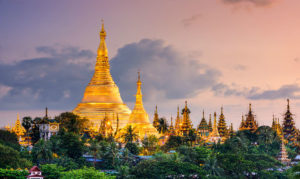
The resplendent Schwedagon Pagoda is Yangon’s main tourist attraction
Mandalay
- Visit the famed U Bien Bridge – 1.3 km teakwood bridge crossing Taungthamam Lake
- Visit Dee Doke Waterfall with its fabled ‘blue waters’
- Visit the impressive 120m high Anisakan Waterfall
- Visit a jade market
- Visit workshops for traditional arts e.g. wood carving, tapestry, robe tailoring etc.
- Visit Mandalay’s Royal Palace – the residence of Burma’s last king (1885)
- Have a night out at Central Park – for food, beer and music
- Climb the 1700 steps to the top of Mandalay Hill – for a superb view of the city
- Tour some of the city’s spectacular religious buildings e.g. Shwenandaw Monastery, Kuthodaw Pagoda, Mahamuni Temple, etc.
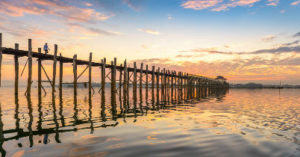
U Bein Bridge at Amarapura was built 1870 – it’s the main tourist attraction in the Mandalay area
Inle Lake (Nyaung Schwe)
- Take a boat tour around the lake – floating markets, stilted villages, Intha fisherman, etc.
- Go cycling around the lake
- Visit Eian Temple Cave
- Visit the ‘Red Mountain’ Winery estate
- Shop at traditional/handicraft markets
- Hill trek to Kalaw (1 to 3 days)
- Visit the In Dein Village – famed for its significant ancient pagodas and stupas
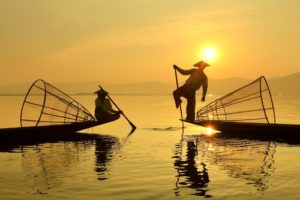
Bagan
The ‘Bagan Archaeological Zone’ is the site of a lost city dating back to at least early medieval times. There are ruins of some 2,200 temples, pagodas and stupas spread over a 50 sq km plain.
- Take a hot air balloon ride over the historic temple plain (1 hr trip costs $300 upwards)
- Explore the temple plain by bicycle/electric bike
- Explore the temple plain by horse buggy
- Explore the Mani Sithu food market
- Shop in nearby Myinkaba town for high-quality lacquerware products
- Watch the sunset over the Irrawaddy River
Some do’s and don’ts
Do’s
- For locals, add ‘U’ or ‘Daw’ (Mr/Miss or Mrs) as a prefix, in reference/or address
- Show appropriate respect to Buddha images or other religious artefacts, at all times
- Dress conservatively when visiting temples i.e. no shorts, short skirts, bare arms etc.
- Respect monks and nuns – give them space! It’s taboo for a woman to touch a monk
- Accept that facilities may not always be up to your expectations
- Locals are normally polite and respectful – reciprocation will put you in a good light
- Take off your shoes when visiting– unless the host says otherwise
- Do leave a small donation at appropriate places
- Do let the oldest be served first
- Do ask permission before taking photographs
Don’ts
- Don’t go to without adequate travel insurance – i.e. adequate cover for medical evacuation
- Avoid illicit drugs – if you’re caught by the police, the consequences can be serious
- Don’t eat food from street vendors
- Don’t hug or kiss in public
- Don’t touch any adult on the head
- Don’t step over any part of a person as it’s considered rude
- Don’t buy artworks from an unauthorised dealer and get a certified receipt
NB: All provided information was correct to the best of knowledge at the time of writing in May 2019
